the Dukeries, Sherwood Forest.
We have forgotten just how important, centuries ago, The Midlands of England were. The Dukeries is the name given in the 18th century to a N.W. district of Nottinghamshire, England, because it contained the estates of no less than four powerful Dukes: The Duke of Newcastle - under - Lyme resided at Clumber Park; the Duke of Kingston at Thoresby Hall (also known as Thoresby House); the Duke of Portland at Welbeck Abbey; and the Duke of Norfolk at Worksop Manor. All these Dukes were descendants of Bess of Hardwick (1527 - 1608), for whom Hardwick Hall was designed
Above: Clumber House, destroyed by fire 1879. Below: Clumber House built 1879, demolished 1938
The Ducal seats of Thoresby, Clumber, Worksop, and Welbeck changed constantly over the decades, sometimes at the whim of the resident, sometimes fire. Clicking on the links will take you to more detailed information and pictures. For information about how the Dukeries were essentially brought about by Bess of Hardwick, see this link. Note: Although often referred to in accounts of the Dukeries, Rufford was not an actual ducal seat, but is included on this blog due to it's strong connections.
Above: Even within living memory, Sherwood Forest has seen much better days. For more information about the famous outlaws of Sherwood Forest visit the Robin Hood Blog. Also, for modern day videos of both Dukeries and Robin Hood related historic sites, visit my Youtube page.
Labels: Bess of Hardwick, Clumber Park, Dukeries, Sherwood Forest, Thoresby, Worksop






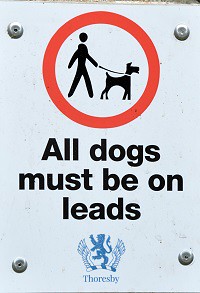 Thoresby Hall Hotel, Sherwood Forest and Clumber Park are recommended attractions for a day trip or short vacation. The
Dukeries area is of keen historic interest. NOTE: Apart from public domain postcards and brochures ALL photographs herein are copyright Ian Gordon Craig, exclusive permission granted to Thoresby Estate for their use elsewhere.
Thoresby Hall Hotel, Sherwood Forest and Clumber Park are recommended attractions for a day trip or short vacation. The
Dukeries area is of keen historic interest. NOTE: Apart from public domain postcards and brochures ALL photographs herein are copyright Ian Gordon Craig, exclusive permission granted to Thoresby Estate for their use elsewhere.
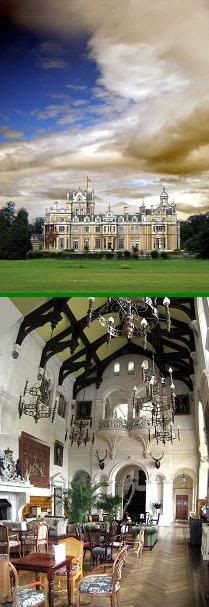 Thoresby Hall as photographed Summer 2009, now a successful Warners Hotel.
Thoresby Hall as photographed Summer 2009, now a successful Warners Hotel.
 Robert Pierrepont (1584 - 1643), 1st Earl of Kingston upon Hull, bought Thoresby for his second son William.
Robert Pierrepont (1584 - 1643), 1st Earl of Kingston upon Hull, bought Thoresby for his second son William.
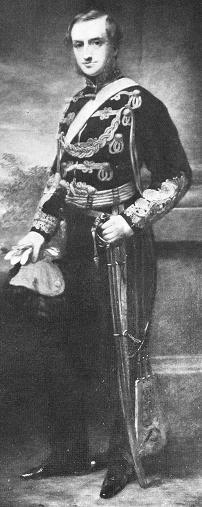 Sydney William Herbert Pierrepont (1825 - 1900), 3rd Earl Manvers, built the present Thoresby Hall, St John's Church,
Perlethorpe School, and generally shaped Thoresby Estate as it looks today.
Sydney William Herbert Pierrepont (1825 - 1900), 3rd Earl Manvers, built the present Thoresby Hall, St John's Church,
Perlethorpe School, and generally shaped Thoresby Estate as it looks today.
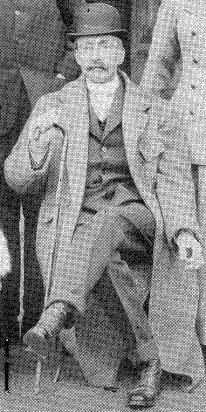 The 4th Earl Manvers (Died 1926).
The 4th Earl Manvers (Died 1926).
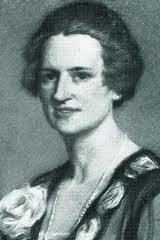 Countess Manvers (d.1984). Examples of her paintings are always on show at Thoresby Gallery.
Countess Manvers (d.1984). Examples of her paintings are always on show at Thoresby Gallery.
 ABOVE: The statue of Robin Hood in the courtyard at Thoresby Hall, by Tussaud - Birt, is showing its age, but remains one of
my favourites. The Art Gallery, crafts shops, and restaurant within that courtyard are recommended.
ABOVE: The statue of Robin Hood in the courtyard at Thoresby Hall, by Tussaud - Birt, is showing its age, but remains one of
my favourites. The Art Gallery, crafts shops, and restaurant within that courtyard are recommended.

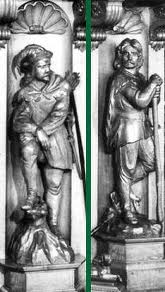
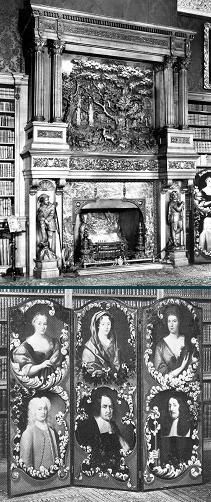 Carved oak fireplace in the Thoresby Hall library with its depiction of the Major Oak (Robin Hood's Tree), and the screen
featuring the Cromwell family. Oliver Cromwell is known to have stayed in Thoresby Hall before the English Civil War.
Carved oak fireplace in the Thoresby Hall library with its depiction of the Major Oak (Robin Hood's Tree), and the screen
featuring the Cromwell family. Oliver Cromwell is known to have stayed in Thoresby Hall before the English Civil War.
 The Green Bridge sited near the edge of the cricket pavilion in front of Thoresby Hall across which the Duke's carriage would take him to Perlethorpe Village.
The Green Bridge sited near the edge of the cricket pavilion in front of Thoresby Hall across which the Duke's carriage would take him to Perlethorpe Village.
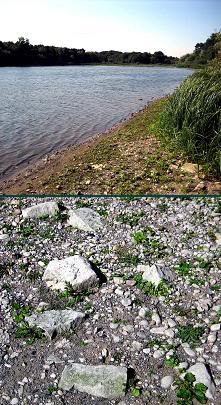 The view along Thoresby Lake towards Budby. Are these bricks at the water's edge remnants from the original Thoresby
Hall?
The view along Thoresby Lake towards Budby. Are these bricks at the water's edge remnants from the original Thoresby
Hall?
 The River Meden winds its way from 7 Ton Bridge near Thoresby Hall towards Perlethorpe Village.
The River Meden winds its way from 7 Ton Bridge near Thoresby Hall towards Perlethorpe Village.
 Budby Castle, once known as William Castle, and the River Meden winding towards Thoresby Lake under the remains of
Pierrepont Bridge, once described as classical and elegant.
Budby Castle, once known as William Castle, and the River Meden winding towards Thoresby Lake under the remains of
Pierrepont Bridge, once described as classical and elegant.
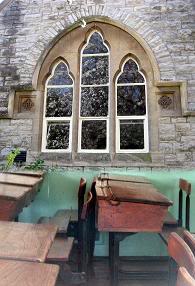
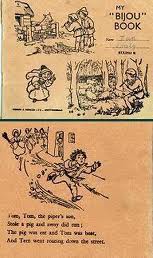 Children's exercise book from the school, 1958.
Children's exercise book from the school, 1958.
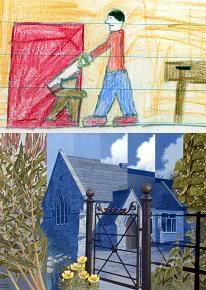
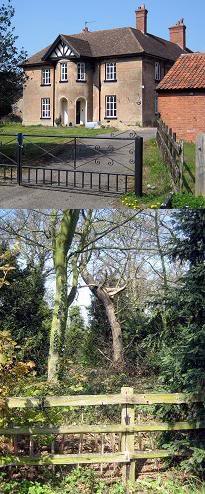



 Perlethorpe Church graveyard, where the original chapel once stood. The covered gate was a later addition in memorium to
the men of Budby and Thoresby who fell in World War 1.
Perlethorpe Church graveyard, where the original chapel once stood. The covered gate was a later addition in memorium to
the men of Budby and Thoresby who fell in World War 1.
 Robin Hood's Tree, the Major Oak, was once under the care and supervision of Thoresby Estate. Responsibility for its
upkeep changed to Nottingham City Council c.1969. Here it is pictured in in Spring, Autumn, and Winter.
Robin Hood's Tree, the Major Oak, was once under the care and supervision of Thoresby Estate. Responsibility for its
upkeep changed to Nottingham City Council c.1969. Here it is pictured in in Spring, Autumn, and Winter.
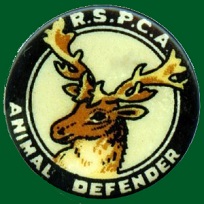
9 Comments:
Interesting stuff of fable and truth all rolled into one big picture ..
I believe Robin Hood was known to the Pierrepont Family and is why they were so endearing to the memory of him .. The Robin Hood statue, now within the courtyard and gallery area, once sat resting in the central green within the intimate grounds of Thoresby hall, at the main entrance. This can be seen in old photographs / booklets of the hall.
Yes our family did also share their family name .. distant or not so distant it's all so questionable .. There is a film in the Pierrepont Family history somewhere as it stems back to 1066 when 2 brothers arrived here as a part of William the Conqueror's task force and then years before in France.. And all to become extinct (1955) for the reason of the establishment .. As prior in 1945 our family connection had been sought. This our being relative is slowly, sadly, becoming a fabled belief too ..
Like a good film, this is where I came in ..
Bonn Soir Mon amis
Paul D. Pierrepont-henson
(Google it .. No Spam Please)
Hello Paul,
And thankyou for your comment.
Yes indeed, I am aware of the original site of the Robin hood statue, having spent the first 13 years of my life on the Estate. If you browse through the whole blog you will see several references to it. Also, mention of how the Pierrepont name arrived with William the Conquerer.
I shall indeed Google your name. And I wish you all the best.
I am sorry if you thought I was pulling you up, or suggesting you hadn't all the relevant info concerning Thoresby Hall (Hotel) etc. Not at all implied by myself, and to add, I am totally amazed at how in-depth the history of it all is detailed within the many pages you air..
Is it all your work?
I take my hat off to you and seriously, I was just having a soap box moment with my comments and not at all directed at anyone in particular.
Best wishes to yourself too
Hi Paul,
No I didn't take it that way at all, nor was I offended. I think these comment boxes sometimes make me sound a little "terse".
All my own work? My 13 years on the estate gave me a good knowledge, but I also make use of Jack Williams' booklet, and Clive Bollands notes, both of whom I credit on the sidebar. Also, now we have the internet, the sources of a lot of Mr Bollands' notes are accessible, and I credit these also.
For photographs I do go back to the estate and take my own, as well as raid the family album for old black and white shots.
The whole thing (along with Robin Hood), started as a simple project to learn how to use basic html. Now it's a kind of pleasant thing to update every now and again.
I see there is a photograph of the old lake that must have stood some where near to where the original Thoresby Hall that Sydney William Pierrepont 3rd Earl Manvers had demolished and had the new and now Thoresby Hall built further up the hill. In those photographs of the waters edge of the lake near Blaby you ask if the large stones as to whether or not are from the old Thoresby Hall? I always thought that the now Thoresby Hall wasn't built that far from where the old Hall had originally stood, and stood where the cricket pavilion is now.
I have also seen on one of my stays at Thoresby Hall Hotel (bar humbug)a painting hanging near to room 808, 2nd floor. The painting is a landscape, winters scene, showing the Hall in the back ground and the green bridge in the foreground ..
Perhaps we are on about the same lakes as there's a stretch of waater close to the green bridge and cricket pavilion ..
What is significance of the greyhounds carved on gateways in Clumber?
In the 16th century a white greyhound was seen as a symbol of status. One appears on Henry 7th coat of arms. It was associated in particular with the Tudors. It was also “designed” and bred as a hunting dog for the rich and privileged. Anyone from the “lower classes” owning such a dog would be prosecuted by law.
From John Holles, the 1st Duke of Newcastle-upon-Tyne in 1715, to the 8th Duke of Newcastle under Lyme, Clumber House was a ducal seat. (The House was demolished in 1938). Hence those greyhounds on the Drayton Gates opposite Clumber Park Hotel, are referred to as Newcastle Greyhounds, carved in the 18th century.
Where the greyhounds were bred, I don’t know. There were once kennels at Clumber, famous for breeding the Clumber Spaniel, another hunting dog but of entirely different appearance.
Greyhound racing was so popular in nearby Worksop that it had its own stadium from 1939 to 1969. I assume that interest in the sport was passed down over centuries by the habits of the Dukes.
Thank you; it’s very interesting to learn new things about our history
I have now realised where the gates are.. I’m not of the area, living in Loughborough. Thank you
Post a Comment
<< Home